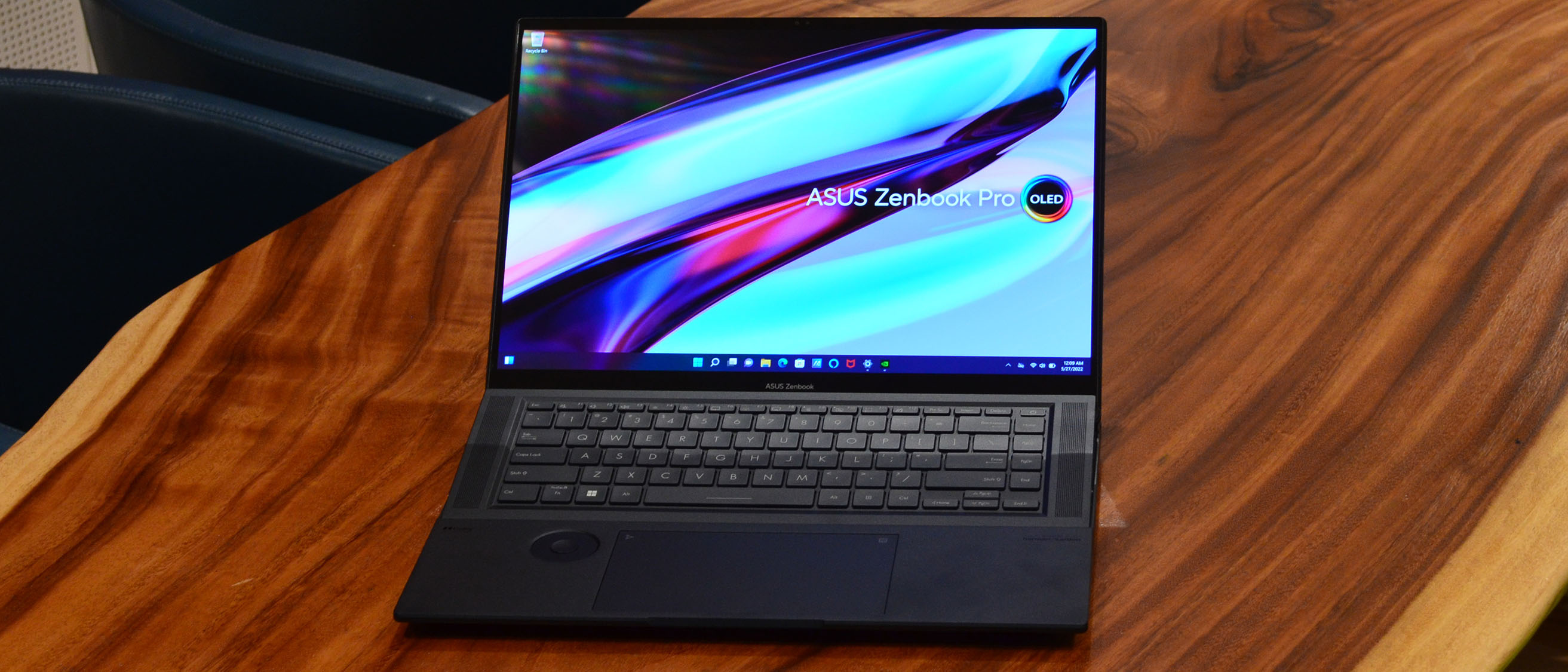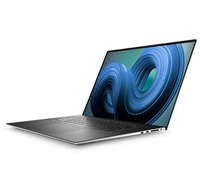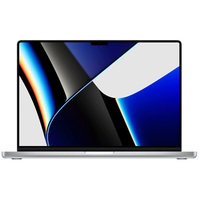TechRadar Verdict
The Asus Zenbook Pro 16X OLED is an elegant machine well suited for creative work. It costs a boatload though, and much of that comes from a design that poses vulnerability concerns that simpler models would steer clear of.
Pros
- +
Dashing looks
- +
Respectable performance
- +
Lots of interface options
Cons
- -
Short battery life
- -
Vulnerability concerns
- -
Pricey
Why you can trust TechRadar
Asus Zenbook Pro 16X OLED: Two minute review
The Asus Zenbook Pro 16X OLED brings the stylings of Asus’ Zenbook family to a head with elegance that can’t be denied. It comes with no shortage of might either, packing performance hardware that can keep up with day-to-day demands and regular creative workloads.
Elegance and power come at a high price, but the Asus Zenbook Pro 16X OLED offers a fair value next to its competitors, like the Apple MacBook Pro 16-inch (2021) and Dell XPS 17 (2022), which all trade blows in performance, design, and price.
For all its style and flair, the Asus Zenbook Pro 16X’s design doesn’t prove as perfectly functional. The keyboard is a bit far forward for comfort, and the way the keyboard lifts up to increase ventilation for the internals in turn exposes the fans to elements better kept away from an expensive laptop's internals.
Even the inclusion of touchscreen and stylus support comes at a cost, with the lovely OLED display being ever-so-faintly washed over by a dot matrix layer that shows itself on close inspection.
If the design were perfect, there’d be little to gripe about. But the reality is this combination of components and a complex design come at a price that will only make sense for a small audience. There are substantially better value options for those who can do without even a small amount of the power on deck here or who can live with a simpler design.
Asus’s own Vivobook Pro 16X comes close to matching this model where it counts, and it costs about half as much. There’s still a mighty CPU onboard, plenty of RAM, a fast SSD, an NVIDIA RTX 3050 Ti (a minor downgrade), and it still rocks a 4K OLED display.
Ultimately, if you want gobs of performance and an elegant design, the Asus Zenbook Pro 16X OLED isn’t a bad offer, it’s just not the best laptop on offer right now.
Asus Zenbook Pro 16X OLED: Price and availability
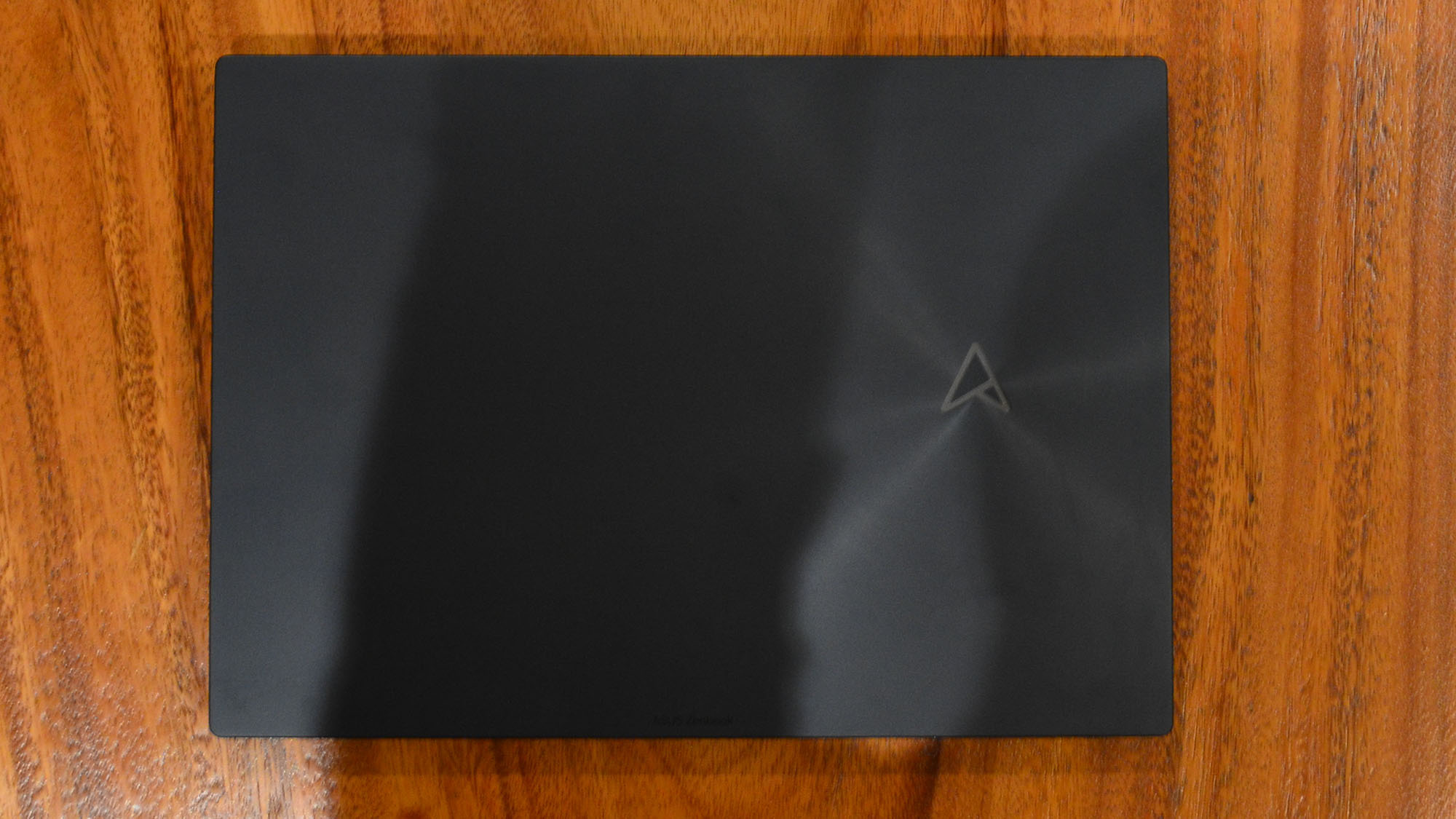
- Starts at $2599 for an Intel Core i7 configuration
- Bumps to $2999 for an Intel Core i9
- Available now
The Asus Zenbook Pro 16X OLED 2022 is available to buy right now, if you’ve got the money. Starting at $2,599 (about £2,590, about AU$3,800) for a US-only model with an Intel Core i7-12700H, NVIDIA GeForce RTX 3060 GPU, 16GB of RAM, and a 1TB SSD, this laptop doesn’t come cheap. That bumps up to $2999 (£2,999, about AU$4,380) to swap up the i7 for an Intel Core i9-12900H, double the RAM, and double the storage. The more expensive model is the only version appearing available in the UK.
- Value: 3.5 / 5
Asus Zenbook Pro 16X OLED: Design
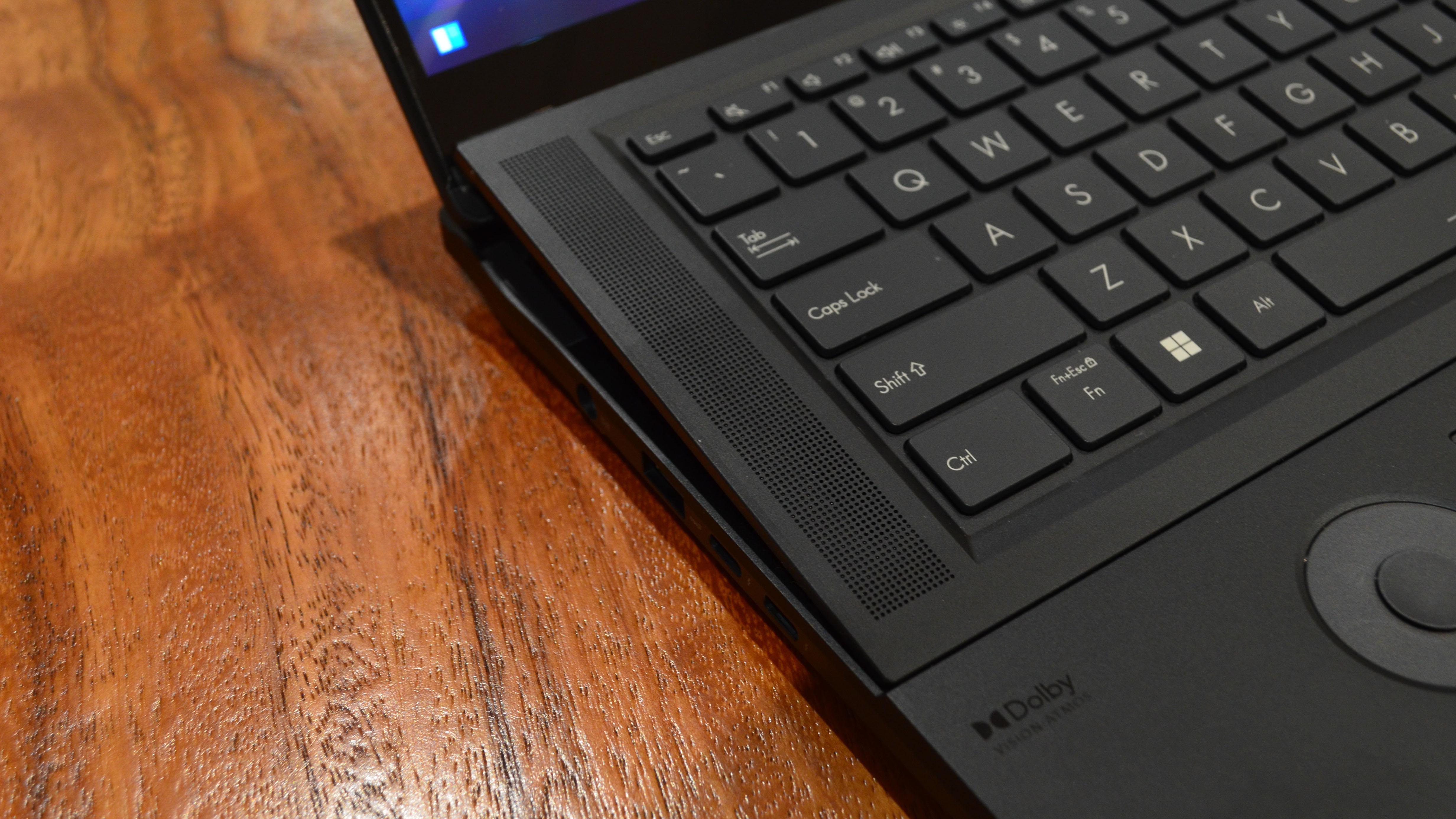
- Mostly marvelous OLED display
- So many things to touch
- Design vulnerability concerns
Here is the Asus Zenbook Pro 16X OLED configuration sent to TechRadar for review:
CPU: Intel Core i7-12700H
Graphics: Nvidia GeForce RTX 3060 6GB; Intel Iris Xe Graphics
RAM: 16GB LPDDR5 (5,200MHz; onboard)
Screen: 16.0-inch, 4K UHD+ (3,840 x 2,400, 16:10 aspect ratio, OLED, 60Hz, multi-touch, stylus-enabled, VESA DisplayHDR 500 True Black, Dolby Vision)
Storage: 1TB PCIe 4.0 NVMe SSD (952GB available)
Ports: 1 x USB-A 3.2 Gen 2, 2 x Thunderbolt 4, headset jack, SD card reader, HDMI 2.1 (FRL)
Connectivity: Intel 802.11ax (2x2) Wi-Fi, Bluetooth 5.0
Camera: FHD (1080p, 2.1MP) IR webcam, Windows Hello
Weight: 5.29 pounds (2.4kg)
Size: 13.98 x 9.88 x 0.7 inches (355 x 251 x 17.8mm; W x D x H)
Asus hasn’t been caught slacking with the designs of its Zenbook family, and that’s as clear as ever on the Zenbook Pro 16X OLED. This is an exceptionally elegant looking laptop. From the deep blue chassis and the chamfered edges of its CNC-machined unibody to the domineering touchpad and the magical, pop-up keyboard, Asus puts its knack for design on full display.
Some aspects of the design don’t feel like they had practicality in mind, though. The keyboard raising up when the laptop is open may serve to provide more airflow for the laptop internals, but it’s not enough of an ergonomic improvement to make up for how far up the chassis the keyboard is — it’s quite a reach and leaves they edge of the laptop digging into our forearms. The per-key RGB lighting isn’t going to fix that. Curiously, Asus also built large rubber strips all around the laptop’s bottom intake vents, so they’re probably not contributing much airflow.
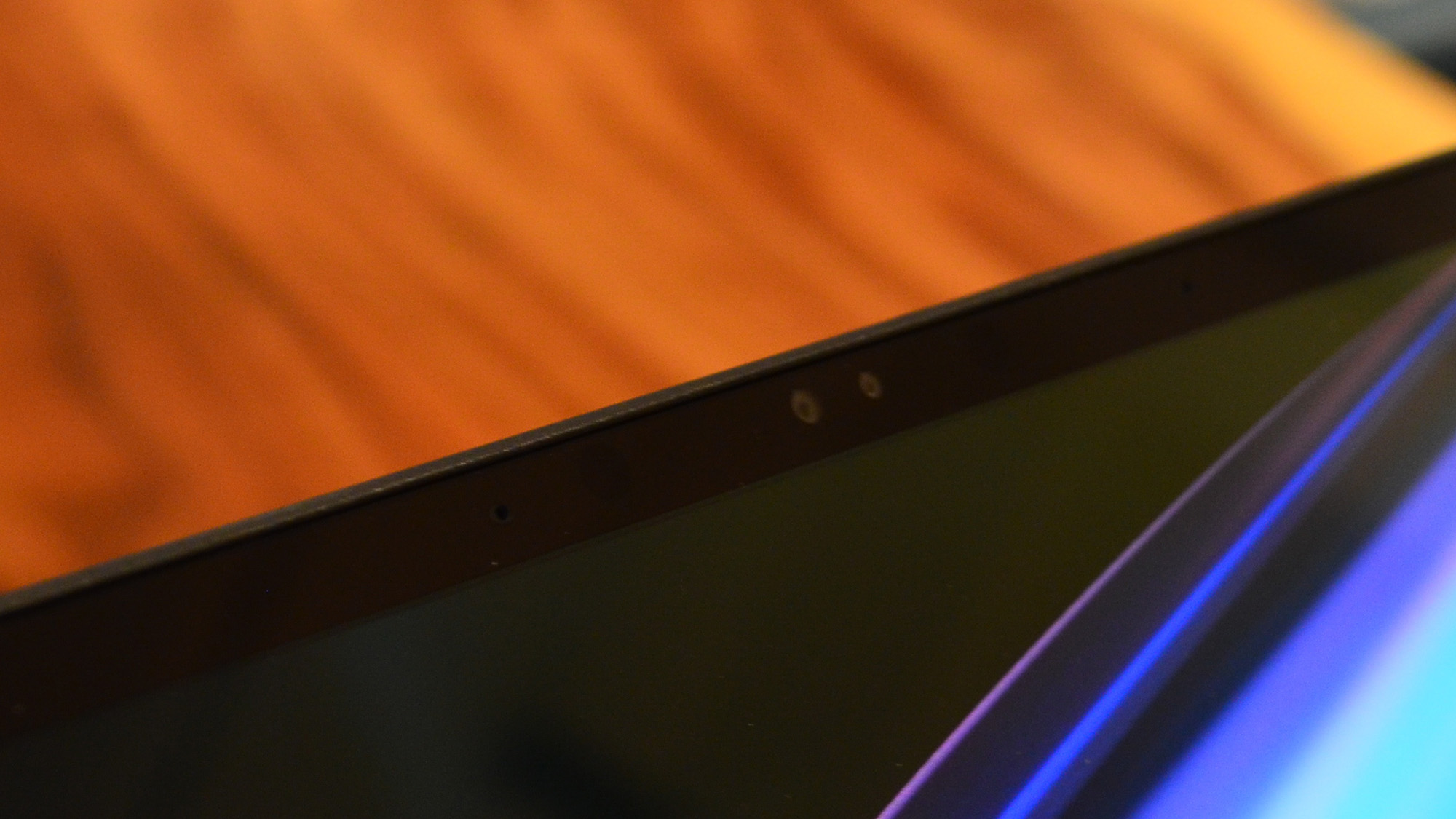
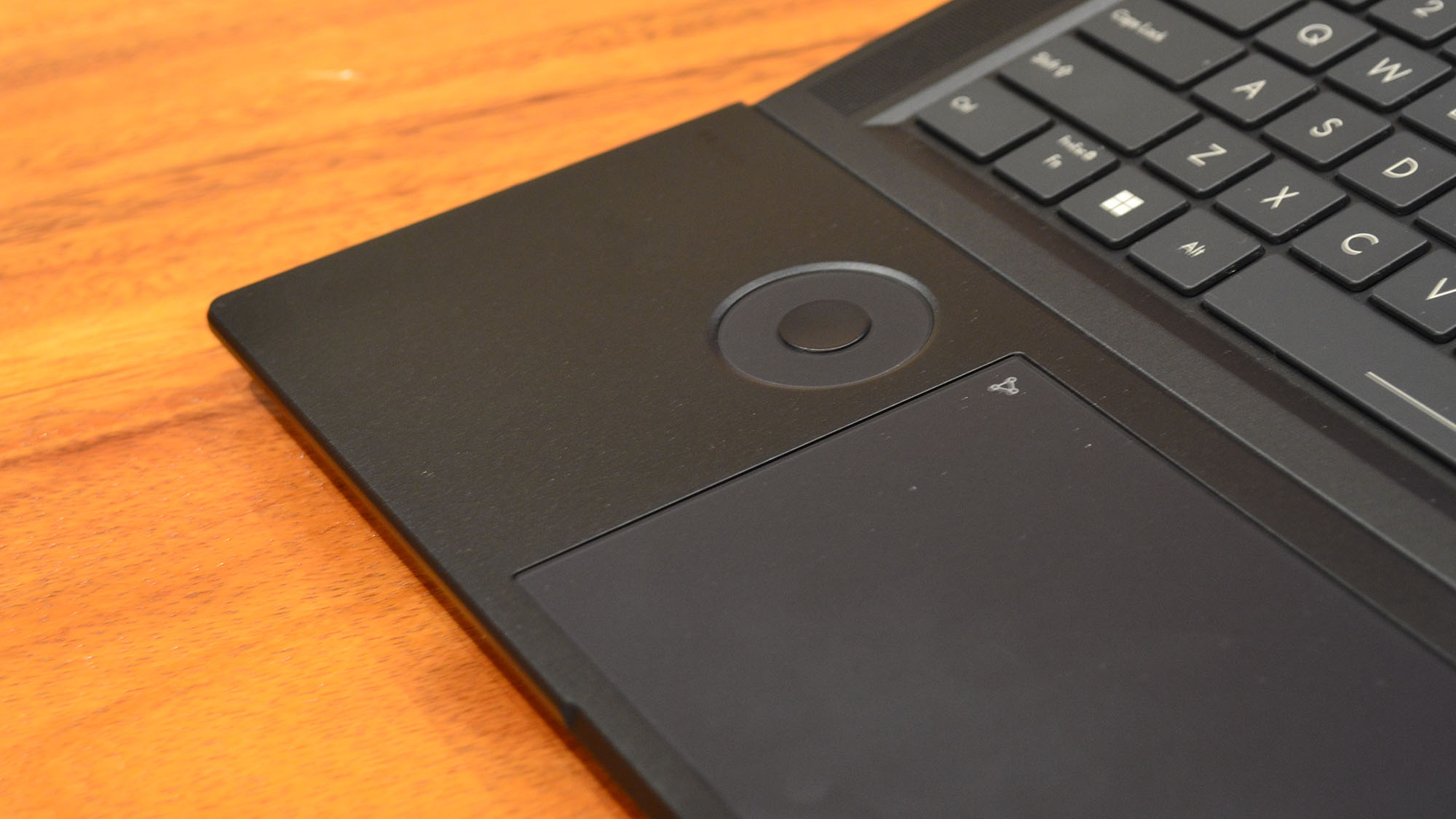
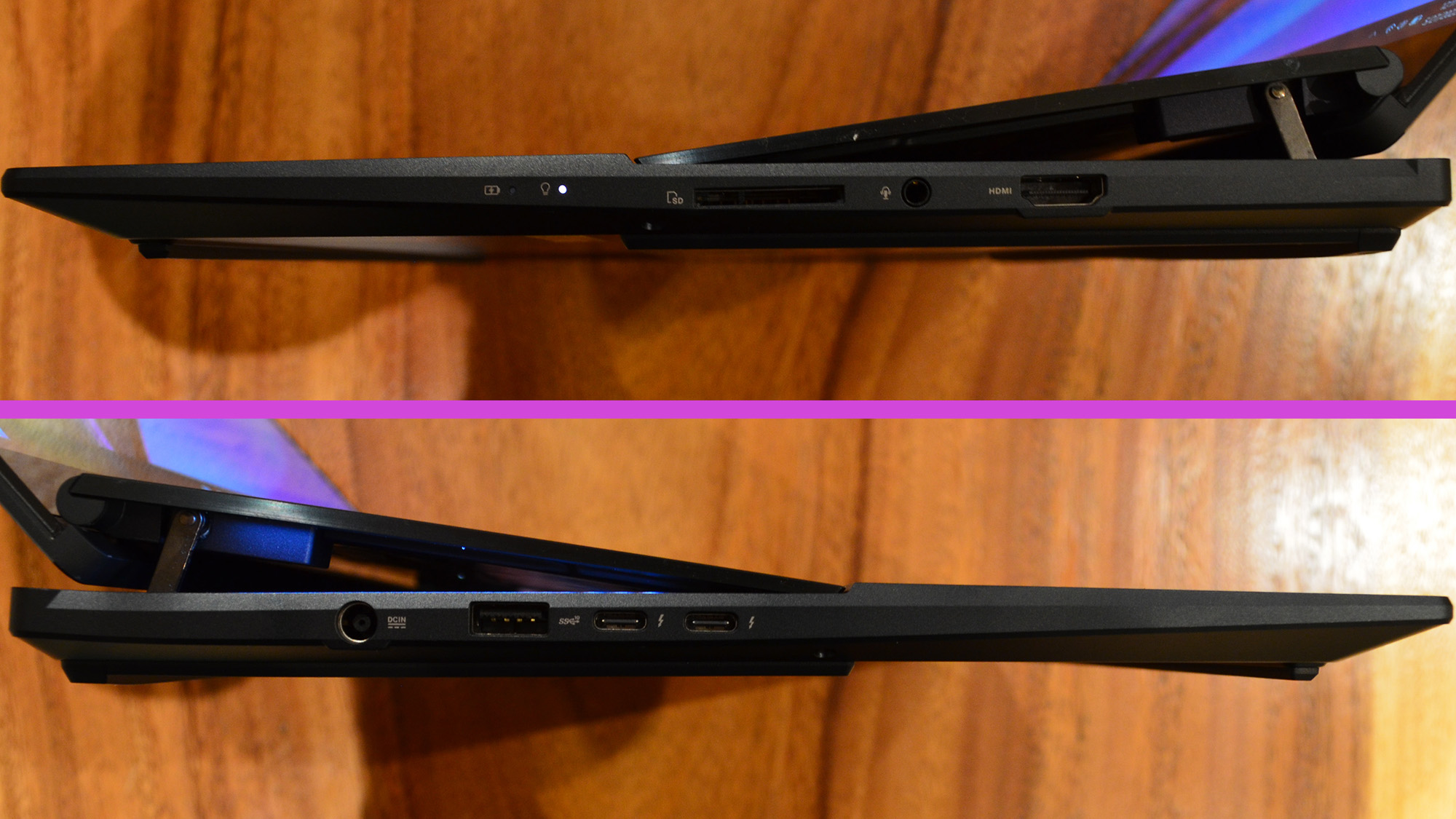
The hinging keyboard design also poses some durability risks, as now just about anything can slither its way into a delicate and hard-to-clean area of the device. If closed with something inside, it seems likely to jam or, worse still, see that thing get pushes into the two fans.
There’s good to the functional aspects of the design, too, though. The keys themselves are pleasantly poppy and don’t have much squish to them. The trackpad makes for easy navigation and has an Apple Force Touch-like vibration response. There’s also a multi-function touch dial to the left of the touchpad, which can be set up with various features (volume and display brightness) by default.
As could be expected, the Asus Zenbook Pro 16X OLED has an exceptional display. It’s 16-inch size is a great fit for the resolution, which goes a bit beyond the typical UHD. The OLED panel produces deep blacks and has a high peak brightness, good for HDR and outdoor use alike. The touch and stylus support comes with one big drawback that becomes noticeable on bright, solid colors, though. It appears to use a sort of dot matrix for touch sensitivity, and it’s plainly visible at times, hindering what would have otherwise been a near faultless display.
- Design: 3.5 / 5
Asus Zenbook Pro 16X OLED: Performance
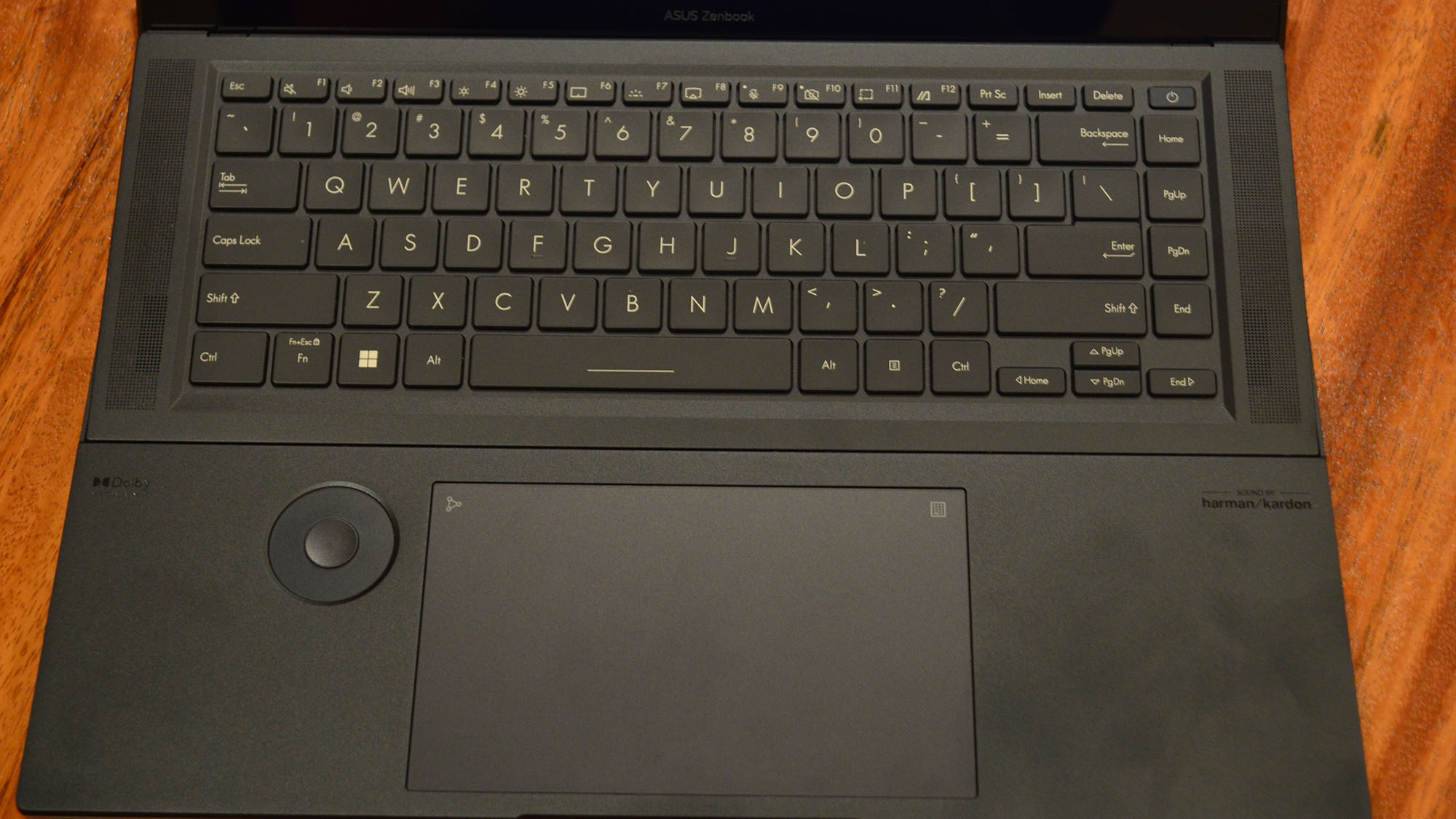
- Performance for everyday work and heavier workloads
- Speedy storage
Here is how the Asus Zenbook Pro 16X OLED performed in our suite of benchmark tests:
3DMark: Fire Strike: 15,593; Time Spy: 7,018, Night Raid: 33,058; Port Royal: 3,867
Cinebench R23 Single: 1746.5; Multi: 12,640
GeekBench 5: 1,776 (single-core); 11,129 (multi-core)
CrystalDiskMark: Sequential Read: 6,634MB/s; Sequential Write: 4,335MB/s; 4KiB Q32T1 Random Read: 341MB/s; 4KiB Q32T1 Random Write: 365MB/s
PCMark 10: 6,336 points
PCMark 10 Battery Life: 9 hours and 37 minutes
Blender: Monster: 54.41; Junkshop: 571.46; Classroom: 498.82
Battery Life (Techradar movie test): 4:37
You have to expect a nearly $3000 laptop to perform, and the Asus Zenbook Pro 16X does for the most part. Combining a powerful processor and capable graphics card, this laptop is able to chew through multi-core rendering tasks. All that performance goes a good way into ensuring smooth performance through day-to-day use as well.
The Zenbook Pro 16X OLED has its work cut out for it, though. At the price, it’s running up against some premium, decked-out laptops, like the Dell XPS 17 2022 and Apple MacBook Pro 16-inch 2021. In the head-to-head, all three laptops take their share of wins and losses, but the Zenbook Pro 16X doesn’t come out squarely ahead. It even falls surprisingly far behind the XPS 17 in multi-threaded CPU benchmarks despite the two laptops using the same processor.
At first glance, it may seem like that’s a bad deal for the Asus Zenbook Pro 16X OLED, because it can cost so much more than configurations of the Dell and Apple. However, once those laptops are configured with the specs that bring them closer to the Zenbook (such as 1TB of storage, an upgraded GPU, and a 4K display), they come much closer in price to the Zenbook. While there’s no clear winner, the Zenbook Pro 16X OLED is worth strong consideration for designers who can benefit from the stylus and touch support.
- Performance: 4 / 5
Asus Zenbook Pro 16X OLED: Battery life
- Long-lasting for productivity
- Short life for entertainment
Having much muscle under the hood tends to come with some big drawbacks in battery life, and we see that here with the Zenbook Pro 16X OLED. It mustered a decent runtime in our PCMark battery test, lasting just over nine and a half hours.
However, it only hit paltry four hours and 37 minutes in our video playback rundown test. When the MacBook Pro 16 can offer similar performance and then run for almost 19 hours in a battery rundown, powerful Windows laptops that can’t break 10 hours are a bad look.
- Battery Life: 3.5 / 5
Should you buy an Asus Zenbook Pro 16X OLED?
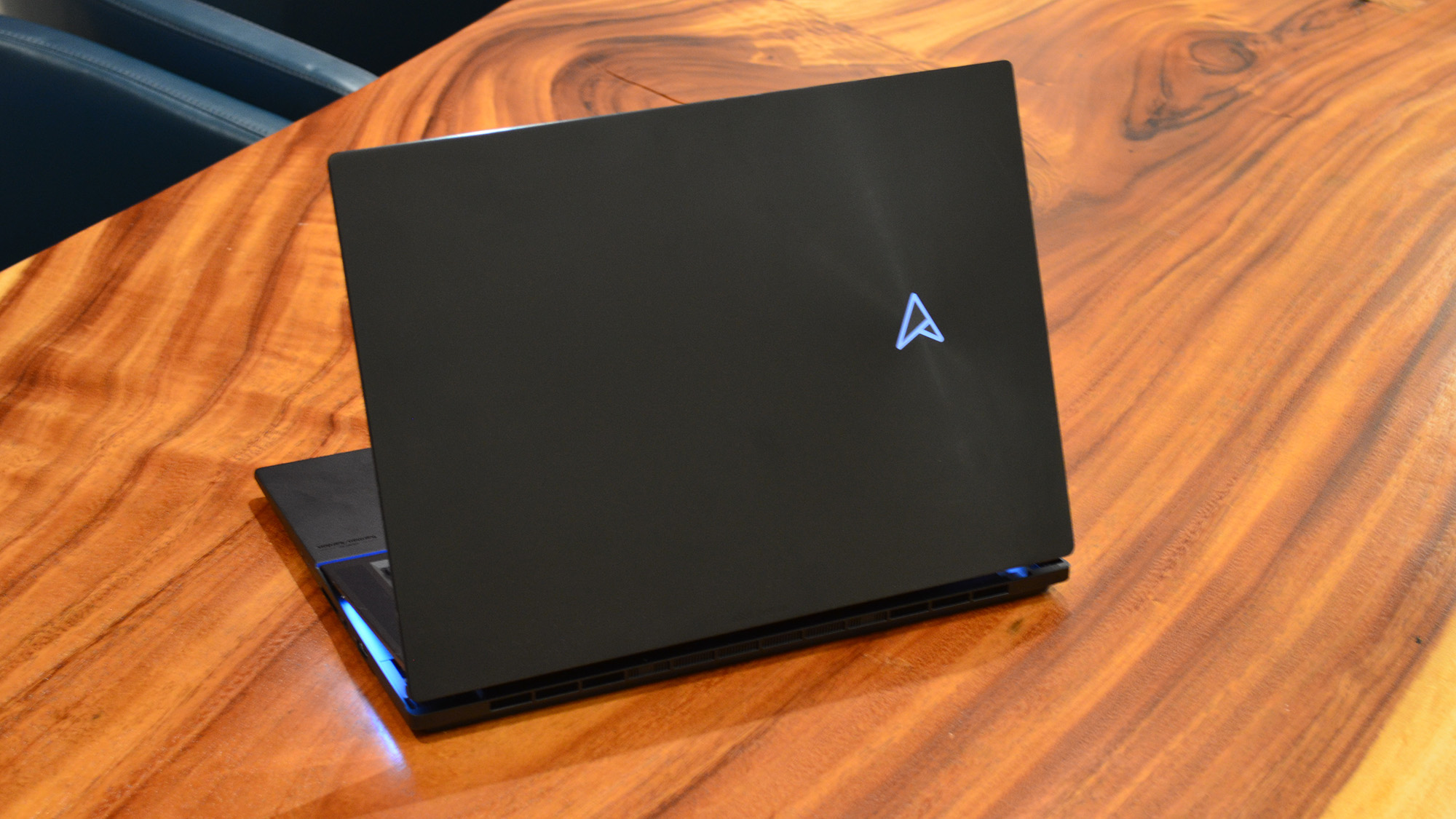
Buy it if...
You want a stylish, performance machine
This laptop looks delicious, and it can cruise along through a wide assortment of tasks. Given that many performance machines get a utilitarian design, this is a delightful exception.
You love OLED
You’re getting a sizable OLED panel on this laptop, and it’s backed by wide color, a preset color calibration, and high brightness levels to help take advantage of Dolby Vision.
You’re crazy about touch controls
The ZenBook Pro 16X OLED has a lot going on for input. The touchpad is massive, has a nice tactile feedback, and can serve as a numpad. The touch dial provides handy controls. And the display supports touch and stylus input.
Don't buy it if...
You want exceptional portability
This is a heft laptop with a so-so battery life. If you’re going to be relying on it on the go, then you’ll also have to haul along its hefty 200W power brick. It’ll fit in a backpack, but you won’t want it in one.
You want a pristine display
Though the display on the Asus Zenbook 16X OLED is a snazzy little number, it falls short of perfection with a visible dot matrix that will irk the pixel peepers among us. It doesn’t help any that it also maxes out at a 60Hz refresh rate while even the extra cheap Zenbook 14 OLED got to hit 90Hz.
You want a machine that you don’t have to be careful with
The Zenbook 16X OLED feels a bit like the Death Star. It’s got a robust, metal unibody design that feels especially sturdy. But the hinge system raising the keyboard to provide more airflow feels like an especially vulnerable area where a simple spill, a bit of dust, or one misplaced cracker could cause critical damage.
Also consider
Dell XPS 17
Dell’s XPS lineup is known for its slick design, and though it’s not as interesting a look as the Zenbook, it’s plenty functional. You can get it kitted out with similar specs and similar price, making it a close competitor to the Zenbook.
Read more: Dell XPS 17 review
Apple MacBook Pro 16 (2021)
If you’re not limited to Windows, the Apple MacBook Pro 16 is a fierce competitor here. It’s mighty in creative workloads, has unparalleled battery life, and challenges laptop OLED displays with its extra-bright Mini LED display.
Read more: Apple MacBook Pro 16 (2021) review
Asus Zenbook Pro 16X OLED Report card
| Value | You’ll get a lot for your money, but a serious portion of the budget is going into the fancy, unique design. Asus’s other laptops show just how much a premium the Zenbook Pro 16X OLED design adds on. | 3.5 / 5 |
| Design | Despite all its elegance, the Zenbook Pro 16X OLED is a bit big for perfectly comfortable use. And its unique design creates a worrying vulnerability. | 3.5 / 5 |
| Performance | This laptop trades blows with others in its product segment, but you can get more performance for your money if design were less of a concern. | 4 / 5 |
| Battery Life | There’s modest life in this battery, but it’s beaten handedly by Apple’s MacBook Pro 16 and the Dell XPS 17. | 3.5 / 5 |
| Total | Row 4 - Cell 1 | 3.63 / 5 |
- First reviewed October 2022
How We Test
We pride ourselves on our independence and our rigorous review-testing process, offering up long-term attention to the products we review and making sure our reviews are updated and maintained - regardless of when a device was released, if you can still buy it, it's on our radar.
Over the last several years, Mark has been tasked as a writer, an editor, and a manager, interacting with published content from all angles. He is intimately familiar with the editorial process from the inception of an article idea, through the iterative process, past publishing, and down the road into performance analysis.
